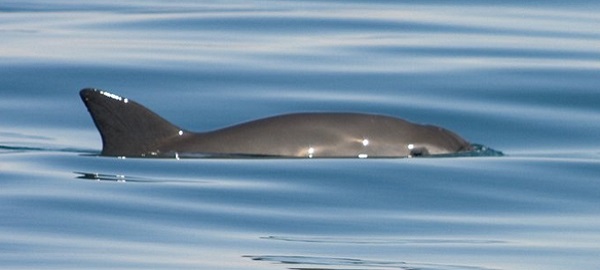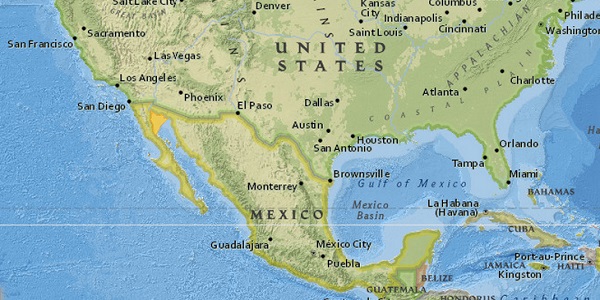
The vaquita is considered a Critically Endangered species by the IUCN. There are an estimated 150 individuals left in the Gulf of California.
o
o
Name
- Scientific name: Phocoena sinus
- Common name: Vaquita, Gulf Porpoise, Gulf of California Porpoise. Vaquita is for “little cow” in Spanish.
Conservation Status
- The vaquita is the most endangered cetacean after the baiji or Chinese River dolphin (Lipotes vexillifer) was declared functionally extinct in 2006. Phocoena sinus is listed as Critically Endangered by the IUCN Red List of Threatened Species.
- In 2007 the IUCN estimated a population of around 150 individuals with a population trend that is decreasing.
- The International Committee for the Recovery of the Vaquita was created in 1997 to protect the species in the Gulf of Mexico.
- The Mexican Ministry of Environment created a Vaquita Refuge in 2005.
- It is listed in CITES Appendix 1
Threats
- The most immediate threat that vaquitas face is being caught in fishing nets.
- Other potential threats are sea pollution, interbreeding, climate change and restricted distribution.
- The vaquita may be following the steps of the Chinese River dolphin (Lipotes vexillifer) which is may be functionally extinct in the wild.
Distribution and Habitat
- They only occur in the northern Gulf of California, Mexico in an area of about 965 sq miles (2,500 sq km) that includes the Colorado River Delta Biosphere Reserve.
- It is Mexico’s only endemic marine mammal and has the smallest distribution of any marine cetacean.
- Their habitat consists of warm, shallow waters of less than 40 meters deep.
- Water temperatures fluctuate from 57.2˚F (14˚C) in January to 86˚F (30˚C) in August.
Physical Description
- The vaquita is the smallest marine cetacean.
- Its skin is dark grey on its back, gradually fading to lighter grey or white on its belly.
- The vaquita can be confused with the harbor porpoise (Phocoena phocoena).
- They are recognizable by the dark rings around its eyes and mouth and they have a dark stripe that extends from the chin to the flipper.
- Calves are darker than adults and have white coloration in its flippers.
- They have between 34 to 40 acorn shaped teeth.
Weight and Length
- Females are slightly larger and heavier than males.
- Males reach up to 4.6 feet (1.4 meters) long and females up to 5 feet (1.52 meters).
- They weigh up to 120 lbs (54.4 kg).
Behavior
- Vaquitas have been seen traveling alone or in groups of up to 3 individuals.
- Large numbers of up to 10 individuals have been seen congregating when food is abundant.
- They spend long periods of time under water and are not usually active on the surface.
- Echolocation also known as biological sonar is used by porpoises and other marine mammals. They emit clicks that travel through the water and once it hits an object the sound bounces back and is analyzed by an organ called melon. Porpoises can determine size, distance and shape of the object.
Diet
- The Gulf of California porpoise is piscivore. Its diet consists of croakers, grunts, squid, crustaceans and octopus.
Reproductive Maturity
- They reach reproductive maturity when they reach 4.27 inches (1.3 meters) between the ages of 3 to 6.
- Mating is seasonal and occurs between April and May.
- Gestation lasts 10 to 11 months.
- They breed every 2 years.
- Number of offspring is 1.
- Calves nurse for less than 12 months.
Life Expectancy
- It is believed that vaquitas live approximately 20 years in the wild. There are no vaquitas held in captivity.
Taxonomy
- Kingdom: Animalia
- Phylum: Chordata
- Class: Mammalia
- Order: Cetacea
- Suborder: Odontoceti
- Family: Phocoenidae
- Genus: Phocoena
- Species: Phocoena sinus
References and further research
⇒University of Michigan Museum of Zoology – Phocoena sinus
⇒Convention on the Conservation of Migratory Species of Wild Animals – Phocoena sinus
⇒Food and Agriculture Organization of the United Nations Fisheries and Aquaculture Department – Phocoena sinus
⇒World Register of Marine Species – Phocoena sinus
⇒Marine Species Identification Portal – Phocoena sinus
⇒Smithsonian National Museum of Natural History
⇒IUCN Red List of Threatened Species – Phocoena sinus
⇒National Oceanic and Atmosphere Administration Office of Protected Resources
⇒The American Society of Mammalogist – Phocoena sinus
⇒Google Scholar – Phocoena sinus
